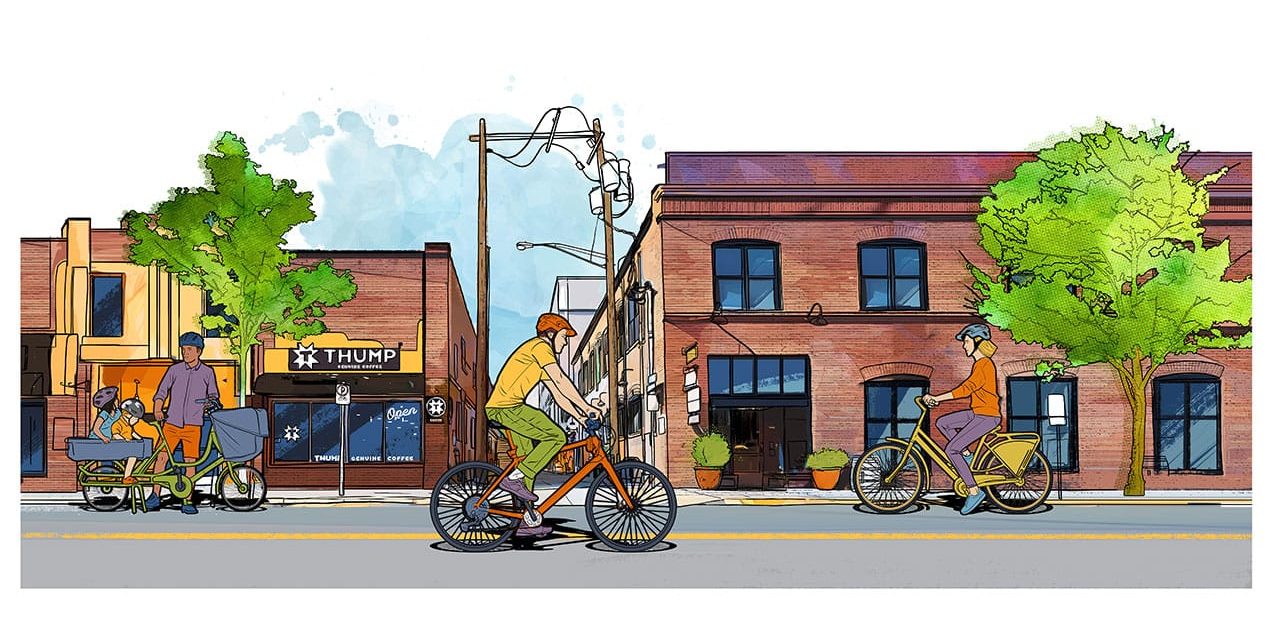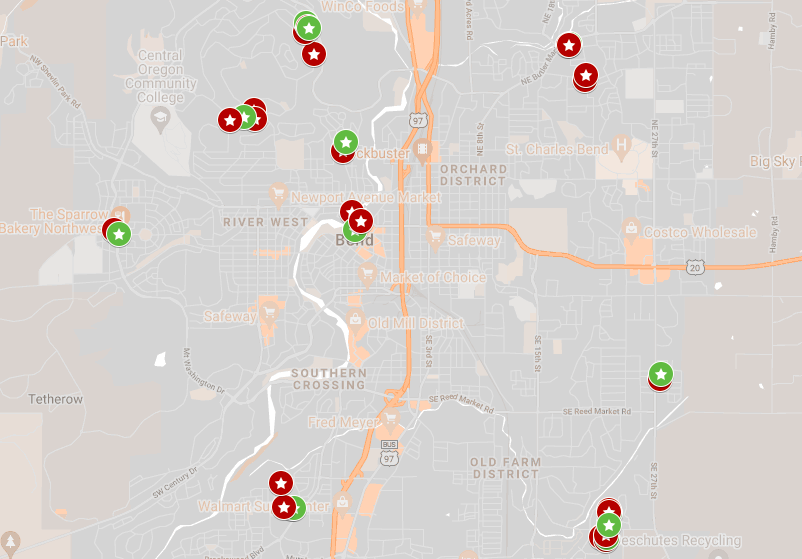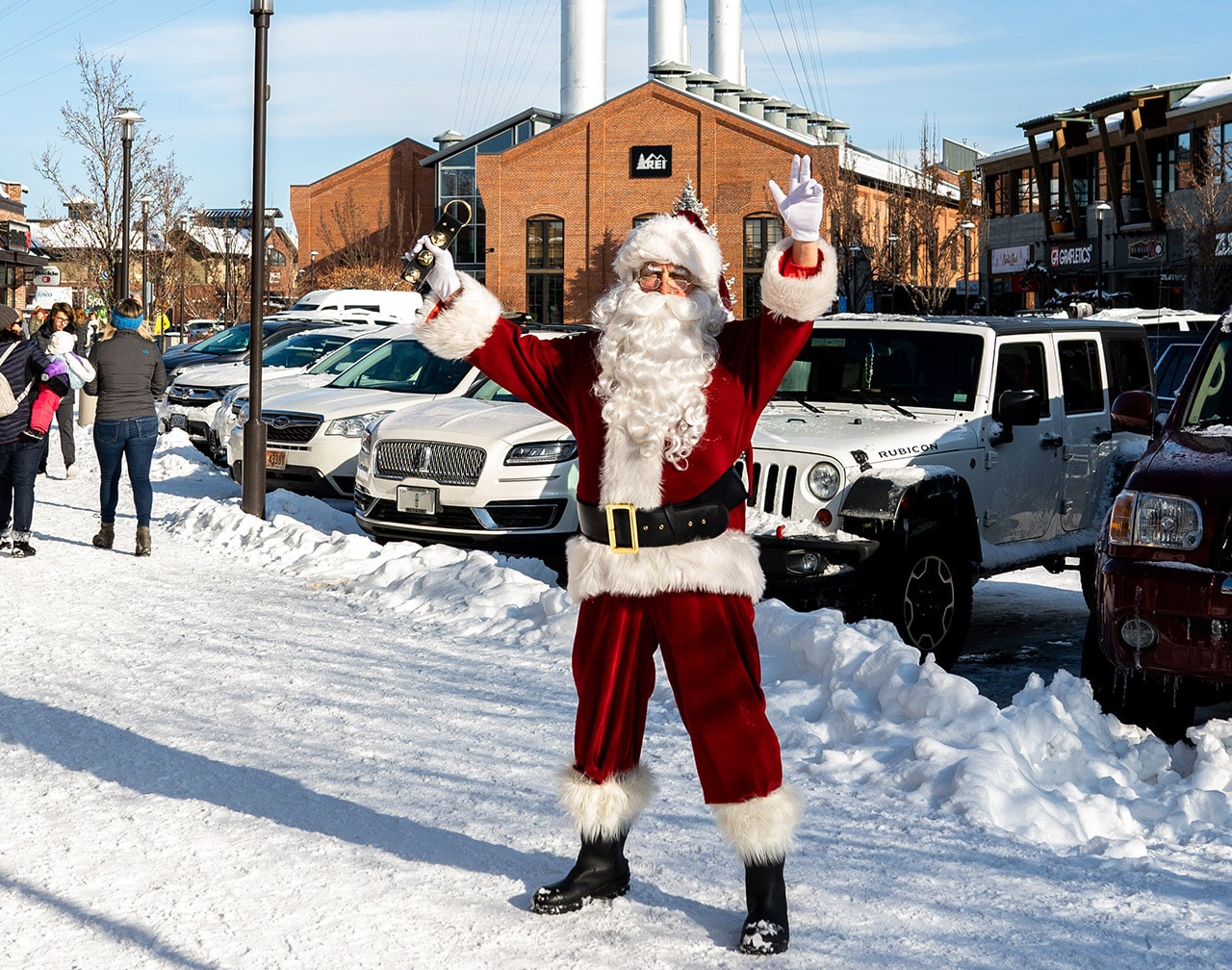City Projects and Nonprofits Pave the Way for Urban Cycling
ILLUSTRATIONS BY DAVI AUGUSTO, INSPIRED BY JOE KLINE PHOTOGRAPHY
As Bend’s summer wanes, residents and visitors look forward to the cooler temperatures on two wheels. Lycra-clad fitness enthusiasts ride scenic bikeways, kids look forward to riding to school and those simply looking for a calmer commute to work or the grocery store enjoy the less-crowded streets in their search for car-free freedom.
Luckily for cyclists, safety in active transportation has become a high priority for local government and cycling nonprofits during the past decade. Education, advocacy and a city council sympathetic to the needs of cyclists have helped remove many obstacles to urban cycling. Dangerous intersections have morphed into protected areas for all users, miles of new bike lanes have been added and plans to separate bikes from cars are in the works. In short, what has been a bike town based around world-class mountain biking is turning into a complete Oregon cycling mecca on the trails and in the streets.
Transportation Plans Map the Future
Building a safe and connected network of bike routes will mean more options, less congestion and less pollution for everyone—visitors and residents alike, explained Bend City Councilor Ariel Mendez. “Good alternatives to driving benefit even people who drive, because it means fewer cars on the road and less competition for scarce parking.”
After years of research, planning and legwork, 2020 saw the Bend City Council adopt the Transportation System Plan (TSP) to adapt to the community’s growing needs for the next two decades. By balancing the diverse needs of Bend’s differing modes of transportation, the TSP aims to uphold the community’s values and protect what makes the city such a desirable place to live. The Bend Bikeway, or one city-wide cycling network including safe east-west and north-south routes, has become a major aspect in achieving Bend’s transportation goals while prioritizing safety.
As a result of the city’s efforts, residents and visitors are seeing upgrades to city roadways. The Wilson Avenue Corridor Project includes painted and separated bike lanes on both sides of the road. Bend’s first protected intersections with physical barriers separating cyclists, pedestrians and vehicles are popping up around town. Safety advocates are happy to see one at the corner of NW Olney Avenue and NW Wall Street where a bicyclist was struck and killed by a turning FedEx driver in 2017.

Greenways and Nonprofits Lead the Way
Perhaps the first indicator that Bend was moving toward bicycle equity was born in 2019 with the creation of Neighborhood Greenways on NE 6th Street and NW 15th Street. The Neighborhood Greenway project is a national idea to describe a route more comfortable for cyclists and pedestrians than nearby busier streets. The roads are equipped with traffic-calming improvements including lower speed limits and speed bumps, traffic circles aiming to slow drivers and signage indicating increased usage by non-vehicular users. The City of Bend has further prioritized non-vehicular travel and discouraged automobile traffic on the 16 current greenways through the installation of traffic diverters.
Kicking off a movement that has helped shift public and political perceptions on non-car transportation, the 2016 Bend’s Open Streets event featured walkers, cyclists, rollerbladers and wheelchair users inhabiting a road blocked to cars. Local nonprofits Commute Options and Bend Bikes led the event and have continued to work toward safer roads for all. Among Bend Bikes’ current list of desired improvements are a complete bike network and map, and more Neighborhood Greenways and protected bike lanes, in an effort to achieve bike equity.
To bring attention to its goals, Bend Bikes held its Bend Bike Night, co-hosted by the City of Bend earlier this summer at The Grove at NorthWest Crossing. The block party started with a “bike bus” consisting of dozens of riders for “safety in numbers,” who pedaled from Larkspur Park in southeast Bend to The Grove where cycling enthusiasts found bike training, education and community. Included in the bike bus pack were Bend Mayor Melanie Kebler, Bend Mayor Pro-Tem Megan Perkins and Oregon Representative Emerson Levy.
Focusing more on education, Commute Options has been touting the advantages of active transportation since its inception in 1991, originally under the moniker Biking for a Better Community. A cornerstone of its programs lies in the state-sponsored Safe Routes To School (SRTS) program. As its name suggests, SRTS focuses on children being able to safely walk or roll to school, thus alleviating the need to be dropped off and picked up by their parents. Benefits to eliminating car travel include not only children’s health and well-being, but improved air quality and congestion around schools. For its efforts, Commute Options added six elementary schools to the program and saw a 50% increase in participation last year.
The Future of Safety
A path toward safe biking in Bend seems to be on an upward trend with progress on the Midtown Crossings Project along Greenwood Avenue. The Hawthorne Overcrossing project is also underway, with construction slated to begin in 2026. “A big opportunity will be in 2026 when the city updates its Transportation System Plan,” stated Councilor Mendez. “Biking is the priority of safety into transportation planning. [It] will mean more kids walking and biking to school, older adults living healthier, independent lives and a more efficient mobile workforce in Bend.”
For now, the City of Bend, transportation nonprofits and advocacy groups can enjoy their successes as they seek to inform the general public on how creating safer bicycle paths is a benefit to cyclists, pedestrians and drivers.





